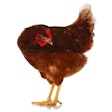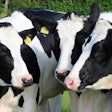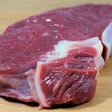
As the season of highest risk for outbreaks of highly pathogenic avian influenza (HPAI) approaches, France is making final preparations for the first vaccinations of the nation’s duck flocks. While new cases in the wild birds continue to be reported widely across Europe, only a handful of outbreaks have been confirmed among poultry flocks in two countries over the past three weeks.
The vaccination strategy to control HPAI in French poultry flocks is on schedule to start at the start of next month, according to agriculture minister, Marc Fesneau.
Preparations for the program were in the final phase, the agriculture ministry reported two weeks ago.
Across the country and throughout the year, vaccination will become mandatory for all commercial farms with Pekin, Barbary or mule ducks. With the state covering 85% of the cost, first vaccinations will be administered to these birds during the first week of October.
Previously, the minister announced that the French government has committed to contribute to cover most of the costs in the event of an HPAI outbreak. This includes compensation to poultry owners whose flocks are culled to control the spread of disease, and also economic losses to those affected in certain areas.
So far this summer, almost EUR30 million (US$32 million) in terms of cash flow support has been paid out to 1,980 of the nation’s farmers, according to Fesneau.
Ahead of the start of the vaccination program, and to reduce the risk of a new HPAI emerging on French duck farms, the density of these birds has been undergoing a reduction since July.
In fact, Fesneau reported, no ducklings have been placed on farms in designated “high-risk” areas for HPAI. This includes 45 municipalities in the western region of Pays de la Loire — the center of duck production in France — or near to sites identified as key for the preservation of avian genetics.
Russia, U.K. report new outbreaks in commercial poultry
Since the start of 2023, there have been 385 outbreaks of HPAI in commercial poultry in 21 European Union (EU) member states and neighboring countries. This is according to the Animal Disease Information System by the European Commission (EC; dated September 8).
This source includes two regions not belonging to the continent of Europe. Totals include two outbreaks in Turkey (Tűrkiye) as well as one in the French overseas territory of Reunion, located in the western Indian Ocean.
No new outbreaks have been reported to the agency since July 27.Of the EC’s total, the country with the most outbreaks — now with 152 — is France. Next come Hungary with 79 outbreaks to date.
For comparison, 24 nations registered a total of 2,321 outbreaks in poultry through this system during 2022.
With the exception of Northern Ireland, the disease situation in the United Kingdom (U.K.) is not covered by the EC System. In recent weeks, the national veterinary agency has officially registered with the World Organisation for Animal Health (WOAH) a further eight cases in wild birds, including some from Northern Ireland.
More recently, three further outbreaks have been confirmed in the U.K. by the agriculture department, Defra.
These appear to be in commercial flocks in Uttoxeter (in the English Midlands), Warrington (in the northwest English county of Cheshire), and Peterhead (in the northeast of the Scottish mainland). They bring to 203 the total confirmed outbreaks among U.K. poultry since October of 2022.
Also excluded from the EC’s animal health publication is Russia.
However, following a brief hiatus, the H5N1 serotype of the HPAI virus has been detected again in the Republic of Tatarstan. Presence of the virus was found after 17,800 poultry died at a farm with a total population of around 195,500 domestic birds.
The Republic is part of the Volga federal district of Russia.
H5N1 virus in Russian backyard flock
Located in Russia's Northwestern federal district is the Komi Republic. In mid-August, a backyard flock of 13 birds there was found to be infected with the same virus serotype, according to a recent WOAH notification.
So far in 2023, 13 countries have together registered a total of 87 outbreaks of HPAI in captive birds through the EC’s system (as of September 8). This total — covering backyard poultry, zoos and similar premises — has not changed since July 10.
Recording the most outbreaks in this category has been France (with a total of 30), followed by Germany (29), and Belgium (11). Each of the other 10 nations in the regions has registered between and four outbreaks.
Widespread cases in wild birds across Europe
Over the period August 20 to September 8, 14 European states notified the EC about one or more cases of HPAI in their respective wild bird populations.
Up to the latter date, a total of 3,272 outbreaks had been registered in 27 states of the EU member and adjacent states, according to the EC System.
The figure has now exceeded the total for 2022. In that year, 33 nations confirmed 3,245 outbreaks in wild birds with the EC’s system.
Germany continues to be the state with the most outbreaks (1,056 for the year to date). Next come France (399), the Netherlands (373), Italy (205), and Belgium (195). All five nations registered new cases with the EC since the previous report update dated August 20.
Furthermore, new cases were also registered over this period by Denmark, Finland, Hungary, the Republic of Ireland, Lithuania, Northern Ireland, Norway, Spain and Sweden.
The U.K. veterinary authority reported to WOAH a further eight cases of HPAI in wild birds.
Meanwhile, the animal health agencies of Austria and Serbia have declared to the Organisation that the HPAI situation in wild birds has been “resolved.”
Finland confirms more infections in non-avian species
Following reports of the H5N1 HPAI virus on a number of fur farms since the end of June, a first infection has been recorded in a wild otter in Finland.
According to the latest WOAH notification from the Finnish veterinary authority, the otter and an additional red fox found dead at different locations tested positive for the virus around one month ago.
Further cases have also been detected among Arctic foxes at another farm. As in previous outbreaks, this premises is located in the region of Western and Inland Finland.
So far, a total of just over 100 animals of three fur species have died of the H5N1 virus infection at the country’s farms.
View our continuing coverage of the global avian influenza situation.


















